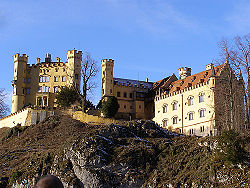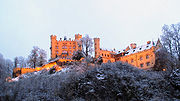
Schloss Hohenschwangau
Encyclopedia

Germany
Germany , officially the Federal Republic of Germany , is a federal parliamentary republic in Europe. The country consists of 16 states while the capital and largest city is Berlin. Germany covers an area of 357,021 km2 and has a largely temperate seasonal climate...
. It was the childhood residence of King Ludwig II of Bavaria
Ludwig II of Bavaria
Ludwig II was King of Bavaria from 1864 until shortly before his death. He is sometimes called the Swan King and der Märchenkönig, the Fairy tale King...
and was built by his father, King Maximilian II of Bavaria
Maximilian II of Bavaria
Maximilian II of Bavaria was king of Bavaria from 1848 until 1864. He was son of Ludwig I of Bavaria and Therese of Saxe-Hildburghausen.-Crown Prince:...
. It is located in the German village of Hohenschwangau
Hohenschwangau
Hohenschwangau is a village in the municipality of Schwangau, Ostallgäu district, Bavaria, Germany.It is located between Schloss Neuschwanstein and Schloss Hohenschwangau and is visited by about 2 million people annually, where they start tours to the former royal palaces.The village is dominated...
near the town of Füssen
Füssen
Füssen is a town in Bavaria, Germany, in the district of Ostallgäu situated from the Austrian border. It is located on the banks of the Lech river. The River Lech flows into the Forggensee...
, part of the county of Ostallgäu
Ostallgäu
Ostallgäu is a district in Bavaria, Germany. It is bounded by the districts of Oberallgäu, Unterallgäu, Augsburg, Landsberg, Weilheim-Schongau and Garmisch-Partenkirchen, and by the Austrian state of Tyrol...
in southwestern Bavaria
Bavaria
Bavaria, formally the Free State of Bavaria is a state of Germany, located in the southeast of Germany. With an area of , it is the largest state by area, forming almost 20% of the total land area of Germany...
, Germany
Germany
Germany , officially the Federal Republic of Germany , is a federal parliamentary republic in Europe. The country consists of 16 states while the capital and largest city is Berlin. Germany covers an area of 357,021 km2 and has a largely temperate seasonal climate...
, very close to the border with Austria
Austria
Austria , officially the Republic of Austria , is a landlocked country of roughly 8.4 million people in Central Europe. It is bordered by the Czech Republic and Germany to the north, Slovakia and Hungary to the east, Slovenia and Italy to the south, and Switzerland and Liechtenstein to the...
.
Hohenschwangau Castle was built on the remains of the fortress Schwanstein, which was first mentioned in historical records dating from the 12th century. A family of knights was responsible for the construction of the medieval fortress, and it served as the seat of the local government of Schwangau. In 1523, the schloss was described as having walls which were too thin to be useful for defensive purposes. After the demise of the knights in the 16th century the fortress changed hands several times. The decay of the fortress continued until it finally fell into ruins at the beginning of the 19th century.
In April 1829 Crown Prince Maximilian (the later King Maximilian II of Bavaria
Maximilian II of Bavaria
Maximilian II of Bavaria was king of Bavaria from 1848 until 1864. He was son of Ludwig I of Bavaria and Therese of Saxe-Hildburghausen.-Crown Prince:...
) discovered the historic site during a walking tour and reacted enthusiastically to the beauty of the surrounding area. He acquired the ruins - then still known as Schwanstein - in 1832. In February 1833 the reconstruction of the Castle began, continuing until 1837, with additions up to 1855. The architect in charge, Domenico Quaglio
Domenico Quaglio the Younger
Domenico Quaglio the Younger was a German painter, engraver, stage designer, and architect. He was the second son of Giuseppe Quaglio and part of the large Quaglio pedigree of Italian artists involved in architecture, indoor fresco decoration, and scenography for the court theaters. He known as a...
, was responsible for the neogothic style of the exterior design. He died in 1837 and the task was continued by Joseph Daniel Ohlmüller (died 1839) and Georg Friedrich Ziebland. Queen Marie created an alpine garden with plants gathered from all over the alps.
Hohenschwangau was the official summer and hunting residence of Maximilian, his wife Marie of Prussia
Marie of Prussia
Marie of Prussia was Queen of Bavaria and the mother of Kings Ludwig II and Otto of Bavaria.-Life:Born and raised in Berlin, she was the daughter of Prince Wilhelm of Prussia, a younger brother of King Friedrich Wilhelm III of Prussia, and his wife Landgravine Marie Anna of Hesse-Homburg...
and their two sons Ludwig (the later King Ludwig II of Bavaria
Ludwig II of Bavaria
Ludwig II was King of Bavaria from 1864 until shortly before his death. He is sometimes called the Swan King and der Märchenkönig, the Fairy tale King...
) and Otto (the later King Otto I of Bavaria). The young princes spent many years of their adolescence here. The King and the Queen lived in the main building, the boys in the annex.


Luitpold, Prince Regent of Bavaria
Luitpold, Prince Regent of Bavaria , was the de facto ruler of Bavaria from 1886 to 1912, due to the incapacity of his nephews, King Ludwig II and King Otto.-Early life:...
lived on the 3rd floor of the main building. He was responsible for the electrification in 1905 and the installation of an electric elevator. Luitpold died in 1912 and the palace was opened as a museum during the following year.
During World War I
World War I
World War I , which was predominantly called the World War or the Great War from its occurrence until 1939, and the First World War or World War I thereafter, was a major war centred in Europe that began on 28 July 1914 and lasted until 11 November 1918...
and World War II
World War II
World War II, or the Second World War , was a global conflict lasting from 1939 to 1945, involving most of the world's nations—including all of the great powers—eventually forming two opposing military alliances: the Allies and the Axis...
the castle suffered no damage. In 1923 the Bavarian Landtag recognised the right of the former royal family to reside in the castle. From 1933 to 1939 Crown Prince Rupprecht of Bavaria
Rupprecht, Crown Prince of Bavaria
Rupprecht or Rupert, Crown Prince of Bavaria was the last Bavarian Crown Prince.His full title was His Royal Highness Rupprecht Maria Luitpold Ferdinand, Crown Prince of Bavaria, Duke of Bavaria, of Franconia and in Swabia, Count Palatine of the Rhine...
and his family used the castle as their summer residence, and it continues to be a favourite residence of his successors. In May 1941, Prince Adalbert of Bavaria was purged from the military under Hitler's Prinzenerlass
Prinzenerlass
Prinzenerlass was the name of a decree issued in 1940 by Adolf Hitler that prohibited all members of Germany's formerly reigning royal houses from joining or participating in any military operations in the Wehrmacht....
and withdrew to the family castle Hohenschwangau, where he lived for the rest of the war.
More than 300,000 visitors from all over the world visit the palace each year. The castle is open all through the year (except for Christmas). Opening hours are 9 a.m. to 6 p.m. (April through September) and 10 a.m. to 4 p.m. (October through March). Guided tours are provided in German, English, French, Italian, Spanish, Russian, Czech, Slovenian and Japanese. Self-guided tours are not available.

